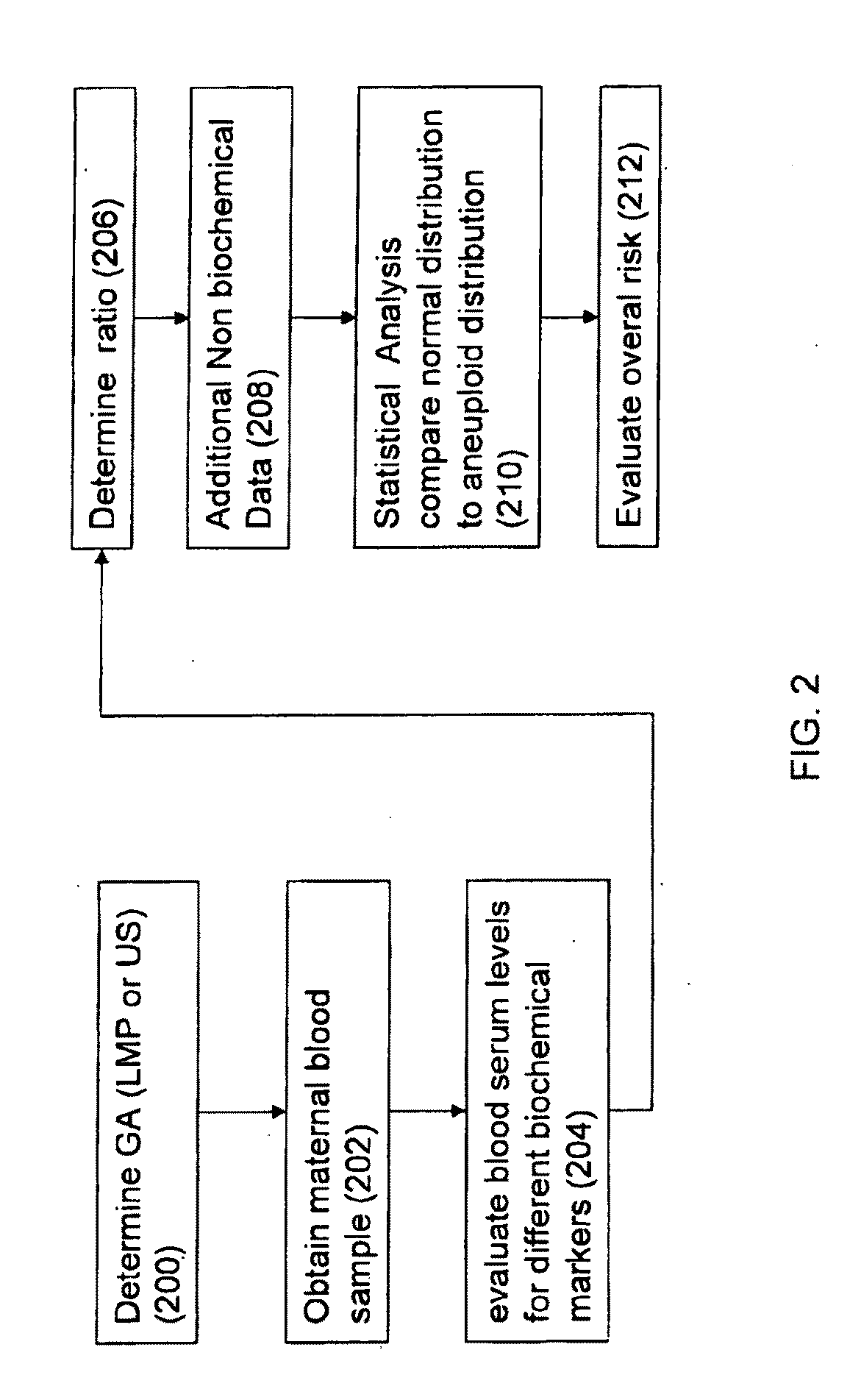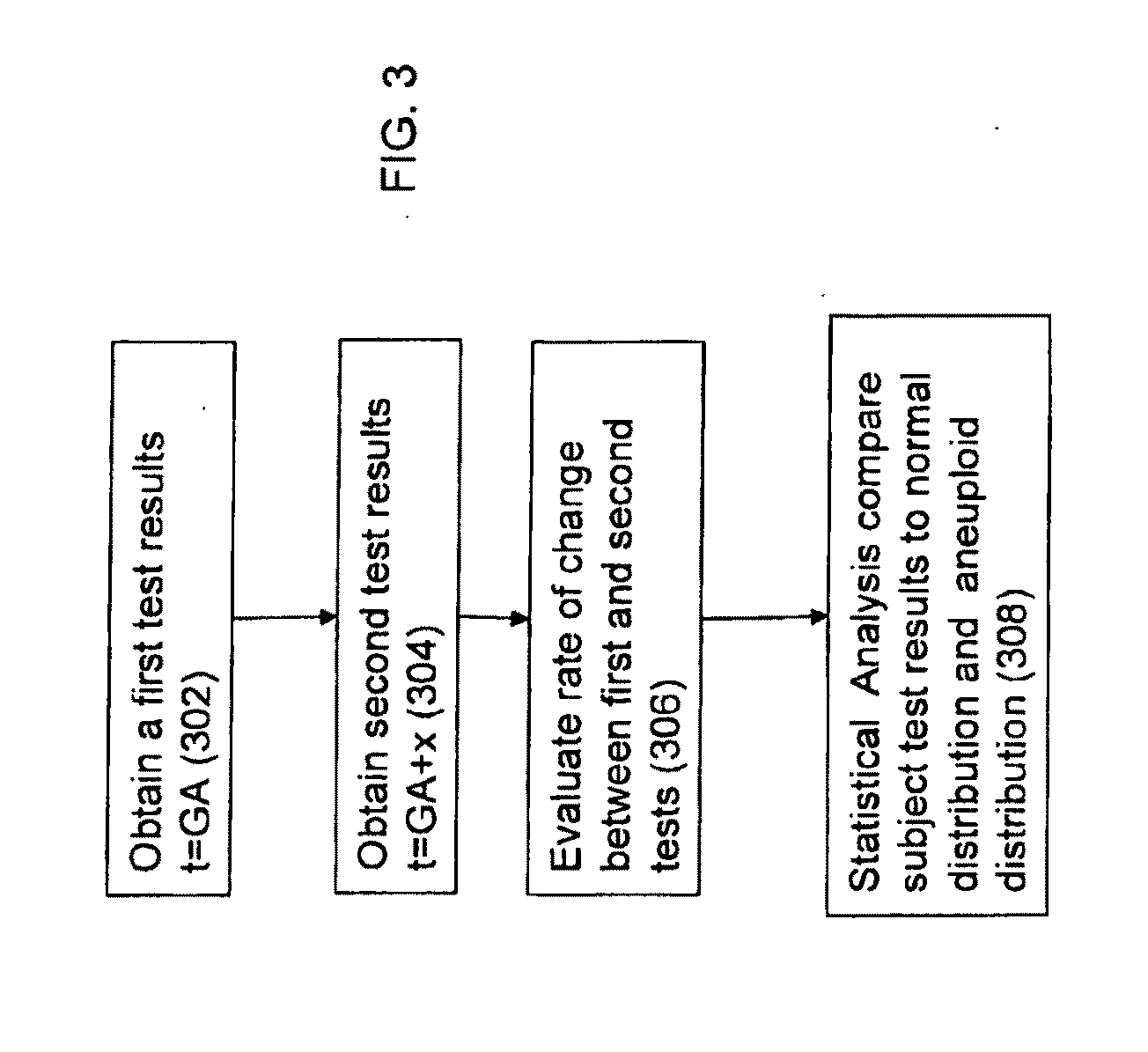Method for antenatal estimation of risk of aneuploidy
a risk and antenatal estimation technology, applied in the field of antenatal estimation of the risk of aneuploidy, can solve problems such as not providing a complete picture, and achieve the effect of lowering false positive detection and increasing detection ra
- Summary
- Abstract
- Description
- Claims
- Application Information
AI Technical Summary
Benefits of technology
Problems solved by technology
Method used
Image
Examples
example 1
[AFP] / [HCG] Ratio
[0061]The below Example relates to actual experimental data, obtained as described, as a non-limiting, illustrative description of an optional method for performing the present invention according to some embodiments.
[0062]Trisomy-21 cases, which were detected through karyotyping at the Genetics Institute of Soroka University Medical Center (Beer Sheva, Israel) over a period of 15 years (between January 1987 and April 2002), were analyzed retrospectively. Altogether, 113 cases of trisomy-21 were detected throughout that period, of which 51 cases could be included in the present set of data. Some of these cases were diagnosed during pregnancy by amniocentesis or by chorionic-villus sampling, while others were detected only after birth. The total number of normal pregnancies, randomly selected to form a control group, was 10365.
[0063]Data collected for all pregnancies included the absolute concentrations of AFP in IU / ml and of beta-hCG in IU / ml. Women's age and gestat...
example 2
Comparative Linear Regression Slope
[0069]The below Example relates to actual experimental data, obtained as described, as a non-limiting, illustrative description of an optional method for performing the present invention according to some embodiments.
[0070]A multi-center study and statistical analysis was preformed to tests the value of using the biochemical marker ratio according to the present invention. The present non-limiting example depicts the results with [AFP] / [hCG] ratio, however any biomarker ratio may be used according to the present invention. The ratio tested was [AFP] / [hCG] to function as a screening test for aneuploidy, particularly trisomy-21. A linear regression model was used to test the relation between the gestational age (GA), expressed in weeks, and the ratio [AFP] / [hCG]
[0071]The abstracted regression model was applied to three individual study centers. Table 3 depicts the regression coefficients beta (β), its standard error, and the 95% confidence interval (...
example 3
False positive analysis ratio vs. triple Test
[0076]The below Example relates to actual experimental data, obtained as described, as a non-limiting, illustrative description of an optional method for performing the present invention according to some embodiments.
[0077]Example 3 depicts further analysis that was performed on the false positive group described in Example 2. Particularly, the analysis was preformed on false positive results where at least a 1:380 risk evaluation was obtained with the triple test, a commonly used screening tool, at various gestational ages during the second trimester. The false positive data was split into three groups relative to the risk assessment obtained with the triple test. The three groups were defined as follows: 1:250 to 1:380 (345 cases); 1:150 to 1:250 (268 cases) and 1:1 to 1:150 (450 cases).
[0078]The three groups were examined and compared to the regression model derived in Example 2. Specifically, the [AFP] / [hCG] ratio, according to a pref...
PUM
 Login to View More
Login to View More Abstract
Description
Claims
Application Information
 Login to View More
Login to View More - R&D
- Intellectual Property
- Life Sciences
- Materials
- Tech Scout
- Unparalleled Data Quality
- Higher Quality Content
- 60% Fewer Hallucinations
Browse by: Latest US Patents, China's latest patents, Technical Efficacy Thesaurus, Application Domain, Technology Topic, Popular Technical Reports.
© 2025 PatSnap. All rights reserved.Legal|Privacy policy|Modern Slavery Act Transparency Statement|Sitemap|About US| Contact US: help@patsnap.com



